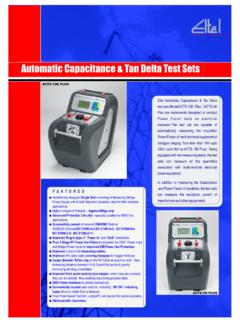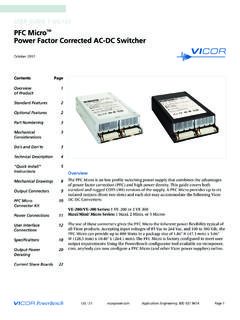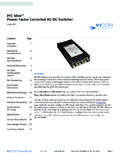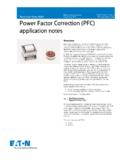Transcription of INSULATION POWER FACTOR TESTING of POWER …
1 INSULATION POWER FACTOR TESTING . of POWER TRANSFORMERS. Oleh W. Iwanusiw, consultant Eltel Industries, Bangalore, India RESUME. This paper discusses the dissipation FACTOR measurements that can be carried out on the INSULATION of POWER transformers during routine maintenance procedures. This presentation includes a definition of terms, outlines measurements and calculations to be performed and discusses the interpretation of test results. INTRODUCTION & DEFINITIONS. Capacitance. Capacitance of a system is defined by the magnitude of charge that it can store at a given voltage. The charge is proportional to the area of the conductive plates, the dielectric constant of the insulating material between the plates and inversely proportional to the distance between them (Figure 1). Vacuum and air have a dielectric constant of 1 and all other insulating materials have a dielectric constant larger than 1. Figure - 1. Capacitance POWER FACTOR , Dissipation FACTOR , Tan Delta.
2 The POWER FACTOR in a circuit is defined as the ratio of POWER to volt-amperes (W/. VA). POWER FACTOR is also defined as the cosine of the angle between the voltage and current in a circuit, with the angle typically referred to as theta'. This angle is typically very close to 90 degrees for capacitive ( INSULATION ) circuits. Dissipation FACTOR is defined as the ratio of POWER to reactive volt-amperes (W/VAr) in a circuit. The Dissipation FACTOR is equal to the tangent of Delta', where Delta' is the angle of 90O minus theta' (Figure 2 for clarification). - 1- For practical INSULATION circuits, where theta' is larger than 85 O, the POWER FACTOR and the Dissipation FACTOR are numerically the same.. Figure - 2. POWER FACTOR / Dissipation FACTOR Grounded Specimen Test. The Grounded Specimen Test (GST) is referred to as the measurement of an INSULATION sample that has one of its terminals grounded. To conduct a GST test, the measuring circuit of the instrument used must be ungrounded to make the measurement possible.
3 As most pieces of electric POWER system equipment is grounded, the grounded specimen test must be used if the equipment is to be tested in the installed condition. GST. is therefore the most important and most frequently used test. Most up-to-date test equipment also offer a grounded specimen test with guard-GSTg. This connection allows one to measure one component of a multi-component, grounded, INSULATION system. Ungrounded Specimen Test. The Ungrounded Specimen Test (UST) is referred to as the test of an INSULATION sample that is not grounded. This test configuration automatically provides a guard'. connection that can be used effectively to measure only one component out of a multi- component INSULATION system. The UST is of great advantage as its guard' connection is also ground'. This means that anything that is grounded in a UST measurement is automatically excluded from the measurement. Cold Guard / Hot Guard Measurements.
4 Cold guard or hot guard connections refer to the potential of the guard' terminal or connection. When the guard potential is at or near ground potential, then it is referred to as a cold guard'. The UST configuration, providing a guard that is also a ground, is therefore a cold guard' connection. When using the GST connection, the guard' potential may be at or near ground potential (cold guard), or at the test potential (hot guard), depending on the configuration of the test equipment. In practice, the cold guard' configuration is typically used in test equipment operating at higher voltage, and the 'hot guard' is used in test equipment operating at low voltage. This is so because of safety considerations, where test personnel may inadvertently mistake the hot guard' terminal as being at ground potential. -2- The primary advantage of the hot guard' connection is that it is more tolerant of interference that is typically encountered in a field test situation.
5 See Figure 3 for UST, GST, Cold Guard & Hot Guard connections. It must be pointed out that typical measuring instruments will feature either the Hot Guard or the Cold Guard connection, not both. 1. UST = GUARD = GROUND, COLD GUARD. 2. GST = LO = GROUND, COLD GUARD. 3. GST = HI = GROUND, HOT GUARD. Figure - 3 Transformer Ratio Arm Bridge POWER Loss. POWER loss or watts loss is the colloquial term often used in connection with INSULATION measurements and refers to the POWER being dissipated in the INSULATION . It is the product of the test voltage, the test current and the cosine of theta'. It is typically used for test specimen that have small capacitance and as a result the POWER FACTOR (tan Delta). of the test circuit is rather high. The POWER loss' is also a very convenient number when checking the accuracy of measurements. Equivalent 10kV value . Capacitance, POWER FACTOR and Dissipation FACTOR are terms that are not affected by changes in test voltage.
6 They can be measured without having to set the test voltage precisely. The POWER loss' or watts loss' values depends on the test voltage (proportional to the square of the test voltage) and therefore needs to be corrected to a reference voltage'. 10 kV has become the preferred reference voltage' when TESTING high voltage electric POWER equipment. A reference voltage' of kV is often used when TESTING equipment rated at distribution or lower voltages. COMPONENTS REQUIRING TESTING . General Comments. It must be pointed out that a single measurement on a transformer typically represents several components within the transformer. For this reason it is necessary to perform certain simple calculations that will separate out individual components for comparison purposes. A good example of this is the situation where the measurement of a transformer includes the winding capacitance and the capacitance of the bushing or bushings.
7 If one wishes to examine only the quality of the winding INSULATION , one must subtract the capacitance and loss of the bushings from the overall measurement. -3- The winding INSULATION of three phase transformers is typically measured together for all three phases. The reason for this is that the windings are interconnected and it is impractical to separate them for the test. It is often possible to separately measure the capacitance of each winding in the factory before the bushings are installed and connected. Bushings. The measurement of bushings is rather simple, provided that they are equipped with a test tap' or a Cap-Tap' as it is often referred to. All modern high-voltage bushings are equipped with this feature. If the bushing is not equipped with the test tap', then one must resort to other techniques to evaluate the condition of the bushing. Using the hot collar' method is one such technique. The actual measurement of a bushing is typically done using the UST connection, and the test tap' may be connected to the test voltage or to the measuring lead.
8 The important measurement is the Tap-to-conductor' capacitance. When in service, it has the system voltage applied to it. The Tap-to-ground' capacitance is shorted out during normal operation of the equipment and is typically not measured. Two Winding Transformers. The simplified schematic diagram of a two winding transformer is shown in Figure 4. It consist of three components, namely: The high voltage winding to ground capacitance (Ch-g), The high voltage to low voltage winding capacitance (Ch-l), The low voltage winding to ground capacitance (Cl-g). The Ch-g and Cl-g measurements include the capacitance of the appropriate bushings. The Ch-g measurement includes the capacitance of the HV bushing and the Cl-g measurement includes the LV bushing. It is IMPORTANT to note that the Ch-l measurement does not include the bushings as the capacitance of the bushings is connected to ground and is automatically removed from the measurement in the UST connection.
9 Figure - 4. 2 Winding Transformers Three Winding Transformers. The simplified schematic diagram of a three winding transformer is shown in Figure 5. Labelling the windings in this transformer as high voltage, low voltage and tertiary, the schematic consists of six components, namely: -4- Note : C H- G, CL -G and CT-G include capacitances of Associated bushings, Figure - 5. 3 Winding Transformers The high voltage to low voltage winding capacitance (Ch-l), The high voltage to tertiary winding capacitance (Ch-t), The low voltage to tertiary winding capacitance (Cl-t), The high voltage winding to ground capacitance (Ch-g), The low voltage winding to ground capacitance (Cl-g), and The tertiary winding to ground capacitance (Ct-g). Similar to the two winding example, all the capacitances between the windings and ground (Ch-g, Cl-g, Ct-g) include the capacitances of the appropriate bushings. The capacitance and loss of the bushings need to be subtracted from the measurement if only the losses in the winding are to be examined.
10 Again, it is IMPORTANT to point out again that the interwinding capacitances (Ch-l, Cl-t & Ct-h) do not include the capacitances of the associated bushings. Insulating Oil. TESTING of insulating oil requires a oil test vessel' in addition to the POWER FACTOR test set. The vessel, or oil test cell' is typically a three-electrode system which provides guarding against surface leakage. This is important as the test cell capacitance is small and even small leakage may cause substantial errors in measurement. Unless the sampled oil is to be subjected to numerous other tests, it is best to directly fill the POWER FACTOR test cell from the sampling facility provided on the tested POWER transformer. One must assure that the test cell is clean and it is a wise precaution to bleed the sampling tube to assure a representative sample. Oil tests in the shop or laboratory would be carried out at room temperature (20O C). as well as at an elevated temperature of 90O or 100O C.






